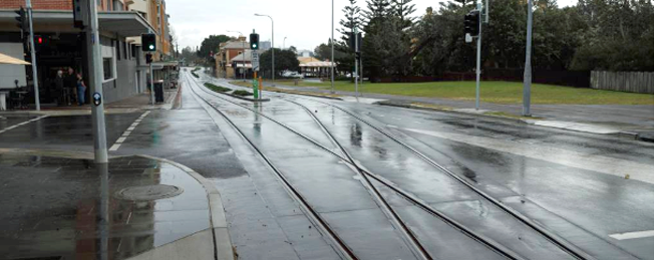Bike riders have been banned from Scott Street in the mixed running section of the Newcastle Light Rail following the completion of the NSW Government safety review.
The review was in response to the tragic death of experienced and much-loved local bike rider 51-year-old Danny Egan earlier this year. Mr Egan was riding his bike across the light rail tracks in July when he fell off, hit his head and tragically passed away from his injuries.
The review confirmed what many in the community already knew, that the ‘shared running’ section between Scott and Newcomen Street along with the terminus at Pacific Street posed an unacceptable risk to people who ride.
What’s alarming is that the government was forewarned about the dangers for bike riders and declined to act.
In budget estimate documents, Transport Minister Andrew Constance said that he had been advised that "road safety risks" existed in this section of track. The dangers were repeatedly flagged in a series of internal safety reports and risk assessments.
Labor had also repeatedly raised concerns about the safety of the light rail tracks while proposing options such as installing track inserts to stop bicycle tyres becoming wedged.
It’s an extraordinary admission from the government - acknowledging that they knew of the dangers yet failed to adequately protect local bike riders. From the outside, it appears that they pushed on with the project at whatever the cost.
The government was aware of danger to cyclists in the Newcastle CBD but went ahead anyway, writes @ianattheherald in the @newcastleherald https://t.co/cjCx4TRmra
— Michael O'Reilly (@MichaelOReilly_) October 16, 2019
The review’s response to the intolerable risks to bike riders were eight recommendations to improve safety with the state government immediately agreeing to adopt them all.
The main recommendation was to ban bikes from the full 340-meter-shared running section of Scott Street as proposed in a submission by NSW Police.
Banning bikes not only unacceptable, it’s lazy and fails to provide any long-term solution or address the problem.
Bicycle Network backs the comments made by Newcastle Cycleways Movement which stated that the government lacked any imagination in addressing the issue and a lack of commitment to providing alternatives.
While the ban stands, it’s critical that the NSW Government work with the local council to provide a viable, connected and safe alternative for people who ride.
It’s been suggested that a section of footpath on the railway station side of the street be converted into a shared path as a short-term solution.
However, a dedicated, separated east-west cycleway should also be explored as a long-term solution.
Another potential solution for the intersection could be clearly marked bike lanes or paths for bike riders through the intersection to indicate the safest path across a complicated crossing of tracks.
In speaking about the bike ban, Executive Director for the Centre for Road Safety Bernard Carlon told the Newcastle Herald that "We do this in other locations where it's not safe for cyclists to access the road network including tunnels and some high-speed roads."
It’s wrong to compare the Newcastle Light Rail on Scott Street with tunnels and some high-speed roads, especially since they’re incomparable. Tunnels and high-speed arterials are designed and build for the movement of vehicles travelling fast, not place.
Streets in our town centres are places for people to shop, eat and socialise. People need to be able to move around in those spaces by bike, walking and public transport. It's not enough to simply ban one mode, especially when we should be making transport alternatives like riding a bike easier, not harder.
It’s also vital that the state government learns important lessons for Sydney’s CBD and Parramatta light rail projects so that the same mistakes aren’t made and risks aren’t ignored.
Become our friend
Find out more about Bicycle Network and support us in making it easier for people to ride bikes.


